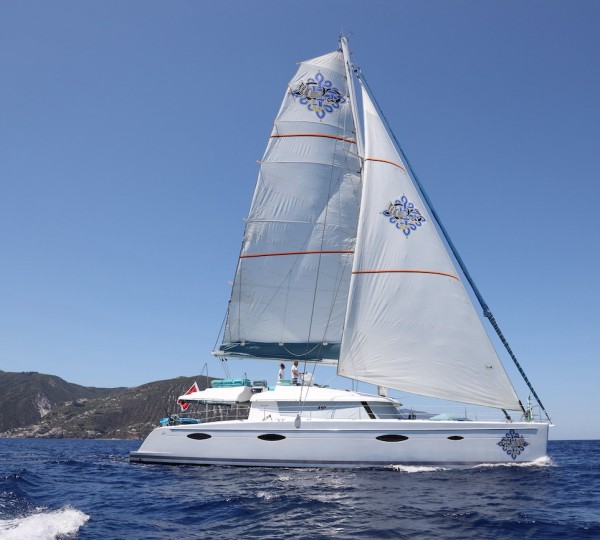
Anchoring procedure
Anchoring your charter yacht can be a very interesting activity on your bareboat yacht charter vacation. The point is to not make it too interesting; that way you can enjoy your charter vacation to its fullest. As with most sound boat handling, the key is forward thinking and preplanning.
This list is merely some general points and will not properly substitute on the water practice. Remember, any procedure that is too prescriptive, or followed to the letter, may not always work the best. Like so many things strong seamanship requires common sense and improvisation with regard to the situation at hand. There are also many different ways of doing things; and anchoring a boat is no different. If you have some comments or suggestions on this article please send us an email. That said, here are a few steps you may like to consider when anchoring you boat:
1. Turn on the engine! It doesn’t matter whether you are going to anchor under power, or showing off and anchoring under sail, you should still have the engine turning over. This means it is ready if for some unforeseen reason should you need it immediately. The best place to find out the engine won’t start is when you are still comfortably under sail, far away from the anchorage, other boats and the shore.
2. Have you got anything towing behind your yacht? The dingy/tender needs to be made fast in such a way that the painter/tow rope will not get sucked into the boat’s propeller. Bring it forward to mid-ships or shorten the towline. Trawling fishing lines into an anchorage can also be a bit embarrassing.
3. Tidy up the foredeck. Make sure the pulpit/foredeck area is cleared of sails and sunbathers and is ready for use.
4. Check out your proposed anchorage area. Find a likely spot for the anchor. Motor past the intended spot and around the likely circle of swing. Are there any obstructions? Is there enough room for the necessary length of chain?
5. Have a good look at the other yachts at anchor. They will give you clues as to how your boat will lie at anchor. Their position will indicate their likely circle of swing. Remember that yachts may have different sized circles of swing because they have different lengths of chain laid out. Some may even be on a mooring and will accordingly have a small circle of swing.
6. Where are the other yacht’s anchors? Remember also that their anchors may not necessarily be positioned straight out in front of them. When there is wind against current a boat may be floating to the side of its anchor, or even directly above it. This may only be apparent once you have dropped your anchor. Don’t be too proud (or lazy) to raise and reset the anchor. It is easier and safer to get things right.
7. Bring the yacht upwind, or up current, depending on which is the stronger of the two. You can yell to communicate with the person on the fore deck who is going to drop the anchor. It is, however, more ‘stylish’ and fun to use prearranged hand signals, provided they aren’t rude. I think hand signals are even better than using UHF radio communicators, as are often used by the crew on superyachts.
8. When you drop it is best if the yacht is stationary or even slightly in reverse. Then reverse back at the same speed that the chain is being laid out. The idea is to lay the chain along the bottom in a straight line. This is better for holding and helps prevent a tangle up that can occur when there is a pile up of chain. You can also set out a trip line if you think there may be a problem retrieving the anchor if you want to prevent other sailors dropping their anchor on yours.
9. Once out, reverse the yacht to dig the anchor in. You can make sure it is fast and not dragging by looking for or feeling any vibration on the chain as the anchor bumps along the bottom. This is the pit where most captains stroll up th the fore deck to inspect their crew’s handy work. If your anchor is dragging and does not eventually dig in before you are too far away from your ideal spot you will have to raise and reset it. Once set, apply the snubber - if you are going to use one. Also, you should raise your black ball or ‘day mark’ now, although in reality this is not very common and often overlooked.
10. If you feel you must, you can set two anchors. Two anchors can be useful for extra holding when you attach one to the other at the crown by a short length of chain. They will then lie in line on the bottom. Two anchors are also useful to reduce the yacht’s swing (where it is sails around in the wind or floats about on the tide). Set one (with chain or rope) reverse back half way, then motor up about 30 degrees from where it was dropped and drop the second anchor. Lay the next anchor out in the same fashion.
11. It make pay dividends to settle in for a few minutes to make sure you are not dragging the anchor and the yacht is safely held. If you rush off immediately to shore or go swimming you won’t be able to see any immediate problems.
12. Remember the basic anchor etiquette of ‘first in first served’. The first boat to anchor in an anchorage has the choice of spot and whether they want to lay a single swing anchor or otherwise.
Well that’s a brief summary of some of some of the things you might like to consider on your yacht charter at anchoring time. It is not meant to be an exhaustive list. If you disagree with any of the points, or feel some have been left out, or would even like to add your own article, please contact us and we will be happy to consider your proposition.
Previous article: Anchoring - things to consider



